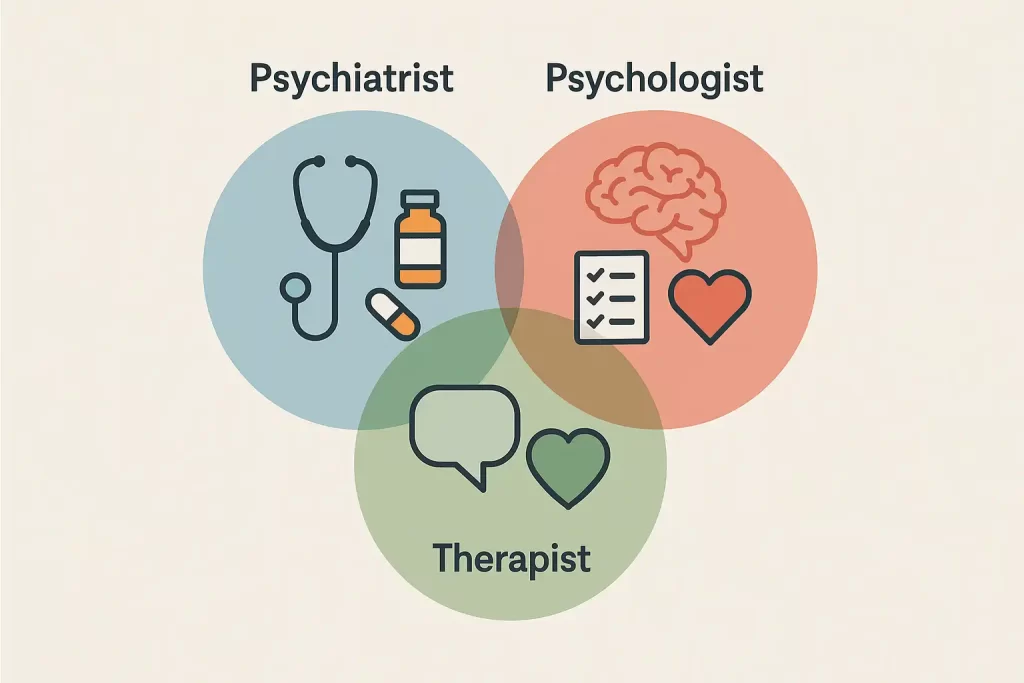When navigating the complexities of mental health, understanding the role of a psychiatrist is critical. As licensed physicians (M.D. or D.O.), psychiatrists uniquely bridge the gap between physical and psychological well-being, leveraging their medical expertise to diagnose conditions like depression, schizophrenia, and PTSD—and prescribing evidence-based treatments, from medication to psychotherapy. Unlike psychologists or licensed therapists, their advanced training equips them to decode how brain chemistry, genetics, and lifestyle intersect with mental health. In this comprehensive guide, we’ll unpack their distinct responsibilities, clarify how they collaborate with other mental health professionals, and detail the conditions they treat—alongside the rigorous education path required to enter this vital field. Whether you’re seeking care or exploring career options, you’ll leave with a clear roadmap of psychiatry’s transformative role in modern mental health.
What Does a Psychiatrist Do?
Psychiatrists are more than mental health experts—they’re medical detectives with a dual mandate. As licensed physicians (holding either an M.D. or D.O. degree), they wield a unique toolkit that blends advanced medical training with psychological insight. After completing rigorous medical school programs and specialized psychiatry residencies, they step into roles that demand precision, empathy, and a deep understanding of how the brain interacts with the body. Here’s how they shape mental health care:
1. Diagnosing the Invisible: Unraveling Complex Mental Illnesses
Psychiatrists are trained to identify and differentiate between overlapping mental health conditions that often baffle untrained observers. For example, they distinguish bipolar disorder’s manic highs from ADHD’s impulsivity or tease apart the intrusive thoughts of OCD from schizophrenia’s hallucinations. Using tools like the DSM-5 (Diagnostic and Statistical Manual of Mental Disorders), clinical interviews, and behavioral assessments, they map symptoms to diagnoses—whether it’s the crushing weight of major depression or the erratic energy of borderline personality disorder.
2. Medication Management: Balancing Brain Chemistry
Unlike psychologists or therapists, psychiatrists prescribe and fine-tune medications to address biological imbalances. They might:
- Stabilize mood swings in bipolar disorder with lithium or anticonvulsants.
- Quiet the hallucinations of schizophrenia using atypical antipsychotics.
- Ease the grip of panic disorders with SSRIs like sertraline.
Each prescription is tailored to the patient’s biology, lifestyle, and side effect tolerance, often requiring months of adjustment.
3. Psychotherapy: The Art of Science-Driven Talk Therapy
While medication tackles biological roots, psychiatrists also employ evidence-based talk therapies to address psychological patterns. A patient with PTSD might undergo prolonged exposure therapy to process trauma, while someone with social anxiety could learn CBT techniques to reframe negative thoughts. Psychodynamic therapy, rooted in exploring past experiences, might help others uncover subconscious drivers of self-sabotage.
4. Collaborative Care: Orchestrating Holistic Healing
Psychiatrists rarely work in isolation. They anchor multidisciplinary teams, partnering with:
- Psychologists for in-depth cognitive assessments.
- Licensed Therapists (LCSWs, LMFTs) to reinforce coping strategies.
- Primary Care Doctors to untangle physical symptoms (e.g., thyroid issues mimicking depression).
This synergy ensures treatments address the whole person—not just a diagnosis.
Key Conditions They Tackle
From common struggles to rare disorders, psychiatrists treat:
Crisis Care: Suicidal ideation, acute psychosis.
They also navigate gray areas, like distinguishing grief from clinical depression or addiction’s overlap with underlying trauma..
Mood Disorders: Major depression, cyclothymia.
Trauma: PTSD, complex grief.
Neurodevelopmental Challenges: ADHD, autism-related anxiety.

Psychiatrist vs. Psychologist vs. Therapist: Key Differences
| Profession | Education | Prescribe Medication? | Primary Role |
|---|---|---|---|
| Psychiatrist | Medical degree (M.D./D.O.) + psychiatry residency | Yes | Diagnose, prescribe medication, provide therapy |
| Psychologist | Ph.D. or Psy.D. in psychology | Rarely (varies by state) | Conduct psychotherapy, psychological testing |
| Therapist | Master’s degree (LCSW, MFT, LPC) | No | Provide talk therapy (CBT, family therapy) |
1. Psychiatrists: The Medical Architects of Mental Health
- Education: Medical school (4 years) + 4-year psychiatry residency.
- Licensing: M.D. or D.O. with state medical license.
- Prescribe Medication?: Yes (in all 50 states).
- Key Role: Diagnose mental illnesses, prescribe and manage medications (e.g., SSRIs for anxiety, mood stabilizers for bipolar disorder), and provide psychotherapy.
- Unique Edge: They’re trained to spot how physical health (e.g., thyroid disorders, vitamin deficiencies) mimics or worsens mental symptoms.
- When to See One: Complex cases requiring medication (e.g., schizophrenia, severe OCD) or dual diagnoses (e.g., depression + diabetes).
2. Psychologists: The Science-Backed Evaluators
- Education: Doctoral degree (Ph.D. or Psy.D.) in psychology (5–7 years).
- Licensing: State psychology license (requirements vary).
- Prescribe Medication?: Only in 5 states (e.g., Louisiana, New Mexico) with additional certification.
- Key Role: Conduct psychological testing (e.g., IQ tests, ADHD assessments), diagnose using the DSM-5, and provide psychotherapy (CBT, DBT).
- Unique Edge: Expertise in behavioral research and specialized therapies like trauma-focused CBT.
- When to See One: For diagnostic clarity (e.g., autism evaluations), trauma therapy, or behavior modification without medication.
3. Therapists: The Guides for Daily Resilience
- Education: Master’s degree (2–3 years) in social work (LCSW), counseling (LPC), or marriage/family therapy (MFT).
- Licensing: State-specific clinical license (e.g., LCSW in California).
- Prescribe Medication?: No.
- Key Role: Provide talk therapy to manage stress, relationships, and mild-to-moderate mental health symptoms (e.g., grief, anxiety).
- Unique Edge: Affordable, accessible care with niche focuses like art therapy, family systems therapy, or addiction counseling.
- When to See One: Life transitions (divorce, career changes), mild depression, or building coping skills.
How They Work Together: A Case Study
Imagine someone with severe depression and suicidal thoughts:
- Psychiatrist: Diagnoses major depressive disorder, prescribes antidepressants, and monitors side effects.
- Psychologist: Administers cognitive assessments to rule out ADHD contributing to low self-esteem.
- Therapist (LCSW): Provides weekly CBT sessions to reframe negative thought patterns.
This team approach ensures biological, psychological, and social factors are all addressed.
Key Takeaway
“Psychiatrists treat the biology of mental illness, psychologists decode the mind, and therapists empower the heart. Need medication or a complex diagnosis? Start with a psychiatrist. Seeking coping strategies or navigating life’s storms? A therapist can help. For assessments or specialized talk therapy, psychologists bridge the gap.”
Conditions Psychiatrists Treat
Psychiatrists manage Psychiatrists are the architects of mental health restoration, addressing disorders that span from deeply ingrained biological imbalances to trauma-shaped behavioral patterns. Their expertise isn’t limited to well-known conditions—they navigate the nuanced intersections of brain chemistry, genetics, and environment that fuel mental illness. Below, we explore the breadth of their work, categorized for clarity but interconnected in real-world complexity.
1. Mood Disorders: When Emotions Become Storms
- Examples: Major depressive disorder, bipolar I/II, cyclothymia.
- Impact: A single depressive episode can reduce productivity by 35% and strain relationships.
- Treatment: Mood stabilizers (e.g., lamotrigine), SSRIs, transcranial magnetic stimulation (TMS), and interpersonal therapy.
- Psychiatrist’s Role: Distinguish situational sadness from clinical depression using tools like the *PHQ-9* questionnaire.
2. Anxiety Disorders: The Body’s False Alarms
- Examples: PTSD, generalized anxiety disorder (GAD), panic disorder.
- Science Behind It: Chronic anxiety shrinks the hippocampus (memory center) by 10–15%.
- Treatment: Beta-blockers (propranolol) for physical symptoms, exposure therapy for PTSD, and mindfulness-based CBT.
- Unique Cases: Differentiate panic attacks (sudden, intense) from GAD’s persistent worry.
3. Psychotic Disorders: When Reality Fractures
- Examples: Schizophrenia, delusional disorder, schizoaffective disorder.
- Hallmark Symptoms: Hallucinations (hearing voices), disorganized thinking, paranoia.
- Breakthrough Treatments: Long-acting injectables (aripiprazole lauroxil) for medication adherence; CBT for psychosis to challenge delusions.
- Stat: 50% of schizophrenia cases emerge before age 25.
4. Addiction: Breaking the Cycle of Dependency
- Scope: Substance use disorders (alcohol, opioids), behavioral addictions (gambling, gaming).
- Biology: Addiction hijacks dopamine pathways—psychiatrists use naltrexone (blocks opioid receptors) and contingency management (reward-based therapy).
- Dual Diagnosis: 45% of those with addiction have a co-occurring mental illness (e.g., depression + alcoholism).
5. Neurodevelopmental Disorders: Wiring Differences from Birth
- Examples: ADHD, autism spectrum disorder (ASD), Tourette syndrome.
- ADHD Insights: 60% of children with ADHD retain symptoms into adulthood, often misdiagnosed as anxiety.
- Innovative Care: Guanfacine for ADHD emotional dysregulation; social skills therapy for ASD.
6. Eating Disorders: When Nourishment Becomes Fear
- Examples: Anorexia nervosa, bulimia, ARFID (avoidant/restrictive food intake disorder).
- Risks: Anorexia has the highest mortality rate of any mental illness (10–20%).
- Integrated Care: Family-based therapy (FBT) for teens, olanzapine to reduce obsessive food thoughts.
7. Personality Disorders: Patterns That Fracture Relationships
- Examples: Borderline (BPD), narcissistic, antisocial personality disorder.
- BPD Focus: 75% self-harm; treatments like dialectical behavior therapy (DBT) reduce suicide attempts by 50%.
- Medication: Mood stabilizers for emotional volatility; antidepressants for co-occurring depression.
Beyond Diagnoses: Tackling Debilitating Symptoms
Psychiatrists also target symptoms that blur diagnostic lines:
- Suicidal Ideation: Crisis intervention with ketamine infusions for rapid relief.
- Insomnia: Prescribing trazodone while ruling out sleep apnea.
- Memory Issues: Differentiating dementia from depression-induced “pseudodementia.”
Holistic Healing: The Biopsychosocial Lens
Psychiatrists don’t just treat disorders—they rebuild lives. For a patient with bipolar disorder, this might mean:
Lifestyle: Sleep hygiene protocols to prevent manic triggers.
Medication: Lithium to stabilize mood swings.
Therapy: Psychoeducation for family members.

Types of Psychiatrists: Subspecialties
Psychiatry, like the human mind itself, is richly layered. Beyond general practice, psychiatrists often immerse themselves in subspecialties that demand nuanced expertise—each addressing distinct life stages, societal challenges, or biological crossroads. Here’s a deep dive into these specialized fields, where science meets empathy in extraordinary ways:
1. Child & Adolescent Psychiatrists: Guardians of Developing Minds
- Focus: Mental health from infancy through age 25.
- Key Challenges:
- Neurodevelopmental Disorders: ADHD (affecting 9.8% of U.S. children), autism spectrum disorder.
- Emerging Conditions: Early-onset anxiety, school refusal, or self-harm in teens.
- Innovative Approaches: Play therapy for toddlers, family systems therapy to address household dynamics.
- Why They Matter: 50% of lifelong mental illnesses begin by age 14. Early intervention can reroute trajectories.
2. Forensic Psychiatrists: Where Mental Health Meets the Law
- Role: Bridge psychiatry and legal systems—assessing competency, criminal responsibility, or risk of violence.
- High-Stakes Scenarios:
- Evaluating if a defendant’s schizophrenia impaired judgment during a crime.
- Advising courts on involuntary hospitalization for individuals posing self-harm risks.
- Ethical Tightropes: Balancing patient confidentiality with public safety.
- Stat: 15% of incarcerated individuals have a serious mental illness—forensic psychiatrists advocate for treatment over punishment.
3. Addiction Psychiatrists: Breaking the Chains of Dependency
- Scope: Substance use (opioids, alcohol) + behavioral addictions (gambling, gaming).
- Cutting-Edge Tools:
- Medication-Assisted Therapy (MAT): Buprenorphine for opioid cravings, naltrexone for alcohol.
- Neurofeedback: Retraining reward pathways hijacked by addiction.
- Dual Diagnosis Focus: 45% with addiction have co-occurring disorders (e.g., depression, PTSD).
- Pandemic Impact: Opioid overdoses surged 30% during COVID-19—addiction psychiatrists are frontline responders.
4. Geriatric Psychiatrists: Navigating Mental Health in the Golden Years
- Specialization: Adults 65+, where aging intersects with mental health.
- Common Battles:
- Dementia’s Shadows: Alzheimer’s-related agitation, vascular dementia.
- Late-Life Depression: Often masked by physical complaints (“I’m just tired”).
- Innovations:
- Antidepressants with Fewer Side Effects: Vortioxetine for seniors prone to dizziness.
- Caregiver Support: Training families to manage sundowning syndrome.
- Demand Boom: With 22% of the U.S. population projected to be over 65 by 2050, this field is critical.
5. Perinatal Psychiatrists: Protecting Mental Health Through Parenthood
- Focus: Pregnancy, postpartum, and the first postnatal year.
- Silent Struggles:
- Postpartum Depression: Affects 1 in 7 mothers, yet 50% go undiagnosed.
- Pregnancy-Linked OCD: Intrusive fears about harming the baby.
- Safe Treatments: Sertraline (SSRI) during breastfeeding, trauma-informed therapy for birth-related PTSD.
- Cultural Shift: Destigmatizing mental health in motherhood—because “baby blues” shouldn’t become crises.
The Unseen Thread: Customized Care Across Lifespans
Whether it’s a toddler’s first panic attack or an elder’s battle with loneliness, these subspecialists decode the silent language of suffering. Their work isn’t just about diagnoses—it’s about restoring agency. A child psychiatrist might equip a teen with ADHD to thrive in college; a perinatal psychiatrist could save a family from generational trauma. Together, they prove that mental health care is never one-size-fits-all.
Why This Matters: Subspecialties ensure that a 75-year-old with depression isn’t treated the same as a 15-year-old—because context changes everything.
How to Become a Psychiatrist: Education & Certification
Becoming a psychiatrist isn’t just a career path—it’s a calling that demands equal parts intellectual rigor and emotional intelligence. Unlike many medical fields, psychiatry requires practitioners to master both the biology of the brain and the poetry of the human experience. Below, we break down the decade-long journey, from undergraduate classrooms to life-changing patient care, while exposing the hidden challenges and rewards along the way.
1. Undergraduate Degree (4 Years): Laying the Foundation
- Focus: Bachelor’s degree (often in biology, psychology, or chemistry).
- Critical Courses: Organic chemistry, neuroscience, statistics—pre-med prerequisites that weed out 40% of aspiring med students.
- Beyond Grades: Top programs look for shadowing experience (e.g., volunteering at suicide hotlines) and research (e.g., studying serotonin’s role in depression).
- Pro Tip: Major in a “non-science” field like philosophy or anthropology to cultivate empathy—it’ll set you apart in med school interviews.
2. Medical School (4 Years): Where Science Meets the Art of Healing
- Structure:
- Years 1–2: Classroom immersion in anatomy, pharmacology, and pathophysiology.
- Years 3–4: Clinical rotations—psychiatry, surgery, pediatrics—to grasp how mental health intersects with physical care.
- Licensing Milestones:
- USMLE Step 1: An 8-hour exam dissecting disease mechanisms (pass rate: 89%).
- USMLE Step 2 CK: Clinical knowledge test with psychiatry-focused patient cases.
- D.O. vs. M.D.: Osteopathic psychiatrists (D.O.) learn holistic, hands-on techniques like cranial manipulation alongside traditional training.
3. Psychiatry Residency (4 Years): Baptism by Fire
- Phase 1 (PGY-1): Intern year—60–80 hour weeks in ERs and inpatient units, managing crises like psychotic breaks or overdose reversals.
- Phase 2–4 (PGY-2-4): Specialized training:
- Child Psychiatry: Diagnosing autism in nonverbal toddlers.
- Addiction Medicine: Administering buprenorphine for opioid withdrawal.
- Psychotherapy Mastery: Conducting CBT sessions for anxiety patients.
- Salary: Residents earn 60k–60k–70k annually—a fraction of attending psychiatrists’ $260k median pay.
4. Board Certification: The Gold Standard
- Process: Pass the American Board of Psychiatry and Neurology (ABPN) exams:
- Written Exam: 200+ questions on psychopharmacology, ethics, and forensic cases.
- Oral Exam: Simulated patient interactions testing diagnostic agility.
- Why It Matters: 85% of hospitals require board certification for credentialing. It signals expertise in evolving treatments like esketamine for depression.
- Cost: $1,900+ for exams + annual maintenance fees.
5. Licensing & Lifelong Learning: Staying Sharp in a Shifting Field
- State Licensing: Pass rigorous background checks and jurisprudence exams (e.g., California’s Medical Board Law Exam).
- Recertification: Every 10 years via:
- MOC (Maintenance of Certification): 30+ hours of CME (Continuing Medical Education) yearly.
- Innovation Requirements: Training in telepsychiatry or genetic testing for medication compatibility.
- Burnout Alert: 44% of psychiatrists report emotional exhaustion—self-care isn’t optional.
The Hidden Curriculum: Skills No Classroom Teaches
- Cultural Competence: Understanding how race, gender, and SES impact mental health access.
- Insurance Navigation: Prior authorizations, formulary battles—40% of a psychiatrist’s week is spent on paperwork.
- TED-Worthy Communication: Explaining bipolar disorder to a terrified parent or convincing a reluctant teen to try meds.
Alternate Paths: Subspecializing Beyond the Basics
- Fellowships (1–2 Years):
- Forensic Psychiatry: Master courtroom testimony and criminal evaluations.
- Reproductive Psychiatry: Treat perinatal OCD or postpartum psychosis.
- Academic Routes: Research roles exploring psychedelics (psilocybin for PTSD) or AI-driven diagnostics.
Key Takeaway
“Becoming a psychiatrist is a marathon, not a sprint—a blend of late-night study sessions, tearful patient breakthroughs, and relentless curiosity. Yet for those who stay the course, the reward is unparalleled: the power to mend minds and rewrite life stories.”
Thinking of Pursuing Psychiatry? Shadow a psychiatrist for a day. If you leave energized, not drained, by the chaos of a psych ER—this might be your life’s work.
When to See a Psychiatrist
Consider consulting a psychiatrist if you or a loved one experiMental health struggles often whisper before they scream. Unlike a broken bone or fever, psychological distress can masquerade as “just a bad day” until it derails relationships, careers, and joy. Knowing when to consult a psychiatrist—a medical expert trained to decode these whispers—can mean the difference between temporary suffering and lifelong recovery. Below, we unpack the often-overlooked signs that demand professional intervention, blending science with empathy to guide your next steps.
1. Persistent Sadness or Anxiety: When “Feeling Down” Becomes a Life Sentence
- Normal vs. Clinical: Grief after loss fades in weeks; depression lingers like a fog, stealing interest in hobbies, meals, and sunlight.
- Red Flags:
- Crying spells that strike without cause.
- Avoidance of social events you once loved.
- Physical symptoms: Unexplained weight loss, chronic fatigue.
- Case Example: A 32-year-old stops attending yoga class, cancels brunch dates, and hears “You’ve changed” from friends—yet feels too numb to care.
2. Hallucinations or Delusions: When Reality Crumbles
- Not Just “Imagination”: Hearing voices that insult or command harm. Believing you’re being surveilled via smartphone.
- Hidden Triggers: Could signal schizophrenia, bipolar mania, or even Parkinson’s disease.
- Action Step: Urgent care needed—psychiatrists use antipsychotics like olanzapine to stabilize acute psychosis within hours.
3. Sleep or Appetite Rebellion: Your Body’s SOS Signal
- Insomnia’s Toll: Chronic sleeplessness doubles depression risk and impairs memory.
- Appetite Extremes: Binging to numb pain or starving to regain “control” (common in eating disorders).
- Psychiatry’s Role: Rule out thyroid issues, then prescribe trazodone for sleep or therapy for emotional eating.
4. Daily Life Feels Impossible: The Invisible Disability
- Burnout vs. Breakdown: Struggling to shower, meet deadlines, or remember appointments isn’t laziness—it’s your brain pleading for help.
- Disorders at Play: ADHD (forgetfulness), PTSD (avoiding triggers), or severe OCD (rituals consuming hours).
- Stat: 1 in 5 adults with untreated mental illness can’t hold a job.
5. Suicidal Thoughts or Self-Harm: A Code Red for the Soul
- Myth-Busting: “Attention-seeking” is a dangerous stereotype. Self-harm (e.g., cutting) is often a desperate bid to feel something amid emotional numbness.
- Immediate Steps:
- Crisis Line: Text 988 (U.S.) for 24/7 support.
- ER Visit: For ketamine infusions or short-term hospitalization.
- Safety Plan: Psychiatrists create step-by-step strategies to survive dark moments.
The Power of Teamwork: How Psychiatrists Collaborate with Therapists
Imagine a 24-year-old with bipolar disorder:
- Psychiatrist: Diagnoses via blood tests and clinical interview, prescribes lamotrigine to stabilize moods.
- Therapist: Weekly CBT sessions to challenge “I’m a failure” thoughts during depressive episodes.
- Outcome: Fewer hospitalizations, rebuilt self-esteem.
Myth vs. Reality: Why “Toughing It Out” Fails
- Myth: “Medication is a crutch.”
- Truth: Just as insulin saves diabetics, SSRIs rescue serotonin-starved brains.
- Myth: “Therapists can handle it alone.”
- Truth: Only 33% with severe depression improve with therapy alone—meds boost success rates to 67%.
When in Doubt: The 2-Week Rule
If symptoms persist beyond two weeks and disrupt two or more life areas (work, relationships, self-care), schedule a psychiatric consult. Early intervention slashes chronicity risk by 50%.
Key Takeaways
- Psychiatrists are medical doctors who treat mental health disorders with medication and therapy.
- They differ from psychologists and therapists in their medical training and ability to prescribe drugs.
- Subspecialties include child psychiatry, addiction treatment, and forensic psychiatry.
- Becoming a psychiatrist requires 8+ years of education and residency training.
Need Help? If you’re unsure whether to see a psychiatrist, consult your primary care doctor for a referral. Early intervention can significantly improve outcomes for mental health conditions.

